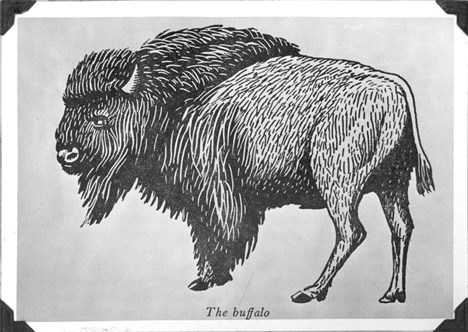When the York Farmers Colonization Company officials of Toronto came in early 1882, to view the land that would become York Colony — 3 miles north of present day Yorkton, they would not have seen any buffalo. But, it had been buffalo country and evidence of this is in an article written by Cliff Shaw who in the 1940s, was reporter of Yorkton news for the Regina Leader Post. He had interviewed Jim Young, whose farm was within the boundaries of old York Colony. Cliff Shaw’s article shows a photo of Jim Young examining a buffalo skull and bones — so numerous as to indicate that a “Buffalo pound” (a ravine or built enclosure used as a hunting method to round-up animals) likely existed there: “The bones are scattered across a coulee which descends to the northwest and drains into the Little White Sand River.” In the 1955 book Saskatchewan authored by J.F. C. Wright, the author explains that even after Confederation in 1867, there were still plenty of buffalo herds roaming the Parklands and Plains of the Canadian North West Territories in search of the best prairie grass pastures. And so, where the buffalo roamed so did the hunters — Aboriginals from various camps before the 1870 Treaties, and Métis migrations from their old homes at the Red River and environs. They went northward along the North Saskatchewan River, westward and finally southward along the international boundary and encampments at spots like the Milk River valley south of the border. The buffalo hunts were their main livelihood, since the buffalo was their major resource for food, clothing, bedding, shelter (tents), and fuel provided by dried dung. Whatever surplus goods they had could be purchased by the Hudson’s Bay Company that still maintained trading posts — the old Forts such as Fort Ellice near St. Lazare, Manitoba, Fort Pelly, Fort Carleton, Fort Qu’Appelle, at the one at Touchwood Hills, etc. Then, when the Parklands became depleted of the buffalo, and getting more and more scarce on the mid-southern plains, the hunters went to a forgotten spot — lush short grass country that became known as a the “Last Refuge” of herds of buffalo. The Hudson’s Bay Company opened a post in the far reaches of present day Southwest Saskatchewan, in the Cypress Hills, where a Company trader, Isaac Cowie traded in 1871-72 with Cree, Blackfoot, Assiniboine and Métis hunters.
Photo — Jackson Collection YJ-0174
Contact Terri Lefebvre Prince,
Heritage Researcher,
City of Yorkton Archives,
Box 400, 37 Third Avenue North
Yorkton, Sask. S3N 2W3
306-786-1722
[email protected]




